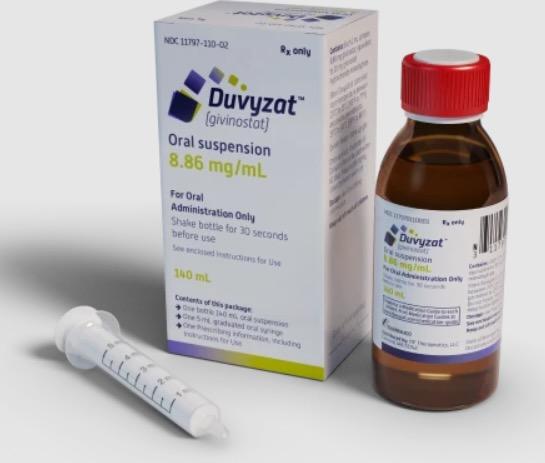Generic Duvyzat Availability
Last updated on Sep 10, 2025.
Duvyzat is a brand name of givinostat, approved by the FDA in the following formulation(s):
DUVYZAT (givinostat hydrochloride - suspension;oral)
-
Manufacturer: ITALFARMACO SPA
Approval date: March 21, 2024
Strength(s): EQ 8.86MG BASE/ML [RLD]
Is there a generic version of Duvyzat available?
No. There is currently no therapeutically equivalent version of Duvyzat available in the United States.
Note: Fraudulent online pharmacies may attempt to sell an illegal generic version of Duvyzat. These medications may be counterfeit and potentially unsafe. If you purchase medications online, be sure you are buying from a reputable and valid online pharmacy. Ask your health care provider for advice if you are unsure about the online purchase of any medication.
See also: Generic Drug FAQ.
Related patents
Patents are granted by the U.S. Patent and Trademark Office at any time during a drug's development and may include a wide range of claims.
-
Physically and chemically stable oral suspensions of givinostat
Patent 10,688,047
Issued: June 23, 2020
Inventor(s): Colombo Giuseppe & Artico Roberta & Mascagni Paolo & Monzani Maria Valmen & Puccianti Silvia
Assignee(s): ITALFARMACO SPAPhysically and chemically stable oral liquid formulations of Givinostat (Diethyl-[6-(4-hydroxycarbamoyl-phenylcarbamoyloxymethyl)-naphthalen-2-yl-methyl]-ammonium chloride) are disclosed, together with methods for the preparation thereof. Such oral formulations are in the form of aqueous suspensions and contain Givinostat and/or pharmaceutically acceptable salts and/or derivatives thereof, at least a wetting agent and/or at least a density-imparting agent. Such formulations are suitable for oral administration for systemic therapeutic action.
Patent expiration dates:
- October 28, 2036✓✓
- October 28, 2036
-
Monohydrate hydrochloride of the 4-hydroxycarbamoyl-phenyl)-carbamic acid (6-diethylaminomethyl-naphtalen-2-yl) ester
Patent 7,329,689
Issued: February 12, 2008
Inventor(s): Pinori; Massimo et al.
Assignee(s): Italfarmaco SpA (Milano, IT)A compound having formula (I) and a process for the preparation thereof are described.
Patent expiration dates:
- January 15, 2026✓✓
- January 15, 2026
-
Diethyl-[6-(4-hydroxycarbamoyl-phenyl-carbamoyloxy-methyl)-naphthalen-2-yl-methyl]-ammonium chloride for use in the treatment of muscular dystrophy
Patent 9,421,184
Issued: August 23, 2016
Inventor(s): Saccone Valentina & Consalvi Silvia & Puri Pier Lorenzo & Mascagni Paolo
Assignee(s): ITALFARMACO S.P.A.The present invention relates to a method for treating muscular dystrophy which comprises administering diethyl-[6-(4-hydroxycarbamoyl-phenyl-carbamoyloxy-methyl)-naphthalen-2-yl-methyl]-ammonium chloride or other pharmaceutically acceptable salts and/or solvates thereof to a patient in need of such a treatment.
Patent expiration dates:
- February 3, 2032✓
- February 3, 2032
-
Diethyl-[6-(4-hydroxycarbamoyl-phenyl-carbamoyloxy-methyl)-naphthalen-2-yl-methyl]-ammonium chloride for use in the treatment of muscular dystrophy
Patent 9,867,799
Issued: January 16, 2018
Inventor(s): Saccone Valentina & Consalvi Silvia & Puri Pier Lorenzo & Mascagni Paolo
Assignee(s): ITALFARMACO S.P.A.The present invention relates to a method for treating muscular dystrophy which comprises administering diethyl-[6-(4-hydroxycarbamoyl-phenyl-carbamoyloxy-methyl)-naphthalen-2-yl-methyl]-ammonium chloride or other pharmaceutically acceptable salts and/or solvates thereof to a patient in need of such a treatment. The invention further relates to a method for treating muscular dystrophy which comprises administering diethyl-[6-(4-hydroxycarbamoyl-phenyl-carbamoyloxy-methyl)-naphthalen-2-yl-methyl]-ammonium chloride or other pharmaceutically acceptable salts and/or solvates thereof in combination with one or more additional anti-inflammatory active agents to a patient in need of such a treatment.
Patent expiration dates:
- February 3, 2032✓
- February 3, 2032
Related exclusivities
Exclusivity is exclusive marketing rights granted by the FDA upon approval of a drug and can run concurrently with a patent or not. Exclusivity is a statutory provision and is granted to an NDA applicant if statutory requirements are met.
Exclusivity expiration dates:
- March 21, 2029 - NEW CHEMICAL ENTITY
- March 21, 2031 - TREATMENT OF DUCHENNE MUSCULAR DYSTROPHY (DMD) IN PATIENTS 6 YEARS OF AGE AND OLDER
More about Duvyzat (givinostat)
- Check interactions
- Compare alternatives
- Pricing & coupons
- Drug images
- Side effects
- Dosage information
- During pregnancy
- FDA approval history
- Drug class: miscellaneous uncategorized agents
- Breastfeeding
- En español
Patient resources
Professional resources
Related treatment guides
Related/similar drugs
Glossary
| Term | Definition |
|---|---|
| Drug Patent | A drug patent is assigned by the U.S. Patent and Trademark Office and assigns exclusive legal right to the patent holder to protect the proprietary chemical formulation. The patent assigns exclusive legal right to the inventor or patent holder, and may include entities such as the drug brand name, trademark, product dosage form, ingredient formulation, or manufacturing process A patent usually expires 20 years from the date of filing, but can be variable based on many factors, including development of new formulations of the original chemical, and patent infringement litigation. |
| Drug Exclusivity | Exclusivity is the sole marketing rights granted by the FDA to a manufacturer upon the approval of a drug and may run simultaneously with a patent. Exclusivity periods can run from 180 days to seven years depending upon the circumstance of the exclusivity grant. |
| RLD | A Reference Listed Drug (RLD) is an approved drug product to which new generic versions are compared to show that they are bioequivalent. A drug company seeking approval to market a generic equivalent must refer to the Reference Listed Drug in its Abbreviated New Drug Application (ANDA). By designating a single reference listed drug as the standard to which all generic versions must be shown to be bioequivalent, FDA hopes to avoid possible significant variations among generic drugs and their brand name counterpart. |
Further information
Always consult your healthcare provider to ensure the information displayed on this page applies to your personal circumstances.

